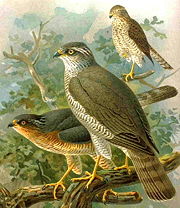Eurasian Sparrowhawk
2008/9 Schools Wikipedia Selection. Related subjects: Birds
| Eurasian Sparrowhawk | ||||||||||||||
|---|---|---|---|---|---|---|---|---|---|---|---|---|---|---|
 larger version
|
||||||||||||||
| Conservation status | ||||||||||||||
| Scientific classification | ||||||||||||||
|
||||||||||||||
| Binomial name | ||||||||||||||
| Accipiter nisus (Linnaeus, 1758) |
The Eurasian Sparrowhawk (Accipiter nisus) is a small bird of prey in the family Accipitridae which includes many other diurnal raptors such as eagles, buzzards, harriers and other sparrowhawks.
It is a widespread species throughout the temperate and subtropical parts of the Old World. It is mainly resident, but birds from colder regions of north Europe and Asia migrate south for the winter, as far as North Africa and India.
This species nests in trees, building a new nest each year. It hunts birds in woodland or cultivated areas, relying on surprise as it flies from a perch or hedge-hops to catch its prey unaware.
This bird is a small raptor with short broad wings and a long tail, both adaptations to manoeuvring through trees. The male is 29-34 cm long with a 59-64 cm wingspan, and is slate-grey above and barred reddish below. The male was formerly called a musket, and the gun called a musket was named after the bird.
The female is much larger at 35-41 cm length and a 67-80 cm wingspan. She is barred grey below, and can be confused with the similarly sized male Goshawk, but lacks the bulk of that species. The juvenile is brown above and barred brown below. The flight is a characteristic "flap – flap – glide".
The New World species formerly known as the Sparrow Hawk (Falco sparverius) is now called the American Kestrel. The new name is preferable, since this bird is not an Accipiter hawk but a falcon.